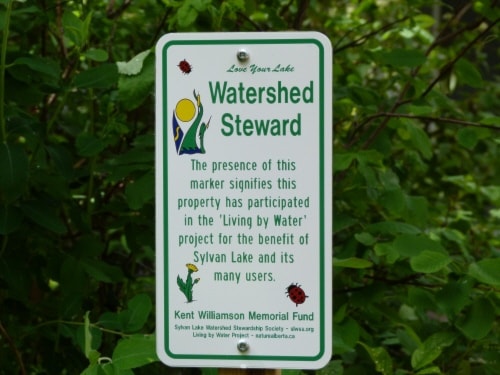Continued involvement in creating a measuring system to ensure the long-term health of Sylvan Lake is being questioned by Sylvan Lake Watershed Stewardship Society.
The organization’s president, Graeme Strathdee, has been involved on the technical advisory team (TAT) working with Sylvan Lake Management Committee and Alberta Environment and Sustainable Resource Development (ESRD) to develop a cumulative effects management system (CEMS) which zeroes in on indicators that affect the watershed.
The first phase of the project delivered an interim report to municipal councillors and at a workshop convened in Sylvan Lake. It’s currently out to all municipalities for acceptance.
“The chance of the project yielding something useful in my lifetime is pretty small,” said Strathdee during the society’s annual meeting Sept. 14. “There’s a hesitancy to continue. It’s a semi-futile exercise to continue along the CEMS route.”
His written report wasn’t as definitive. “The value of ongoing involvement with the TAT is under review by the SLWSS president and the board.”
The management system involves all of the municipalities through their plans and councillors, he said. Embedded within provincial programs are requirements to look at three elements — environmental, social and economic components of land use. While they’ve spent three years working on the environmental aspect, Strathdee said the “social element has kind of been fumbled” and the “ecomomic element has been forgotten”.
“One of the reasons for being there is to carry our thoughts forward. One giant problem with the whole process is municipalities have vetoes. When you get CEMS in place somebody still has decisions for land use.”
Another of the projects of the society has been to create a “Sylvan Lake Watershed Rulebook”. Contraventions under Canadian federal laws and offences and penalties under Alberta provincial laws have been compiled on their website for reference by municipal governments and enforcement agencies.
“We’ve taken the time to download all the stuff from relevant federal and provincial legislation,” said Strathdee. “It’s interesting to see the pattern of offences. It’s weak in a couple of areas. The Municipal Government Act is one and Alberta Sustainable Resource Development is another. In reality the lake is not well protected in law, municipalities are even weaker.”
A flagship project of the society is Living By Water which has been underway for four years in partnership with Nature Alberta led primarily by Steven Johnson, Kim Schmitt and Brian Saby. After four years, 67 property owners have enrolled for the home assessment program where representatives from Nature Alberta work with them to look at how they’re living by the lake and suggest ways to improve their effect on the area. “It’s become so important to us that the board agreed to contribute $4,000 to work around Sylvan Lake on assessments,” said Strathdee. A report on the work in 2013 is posted on the society’s website. Participants also get a ‘Watershed Steward’ sign sponsored by the Kent Williamson Memorial Fund that recognizes their commitment to a healthy watershed.
Strathdee stated “no nutrients is good nutrients” while showing a graph of total phosphorous in lake water analysis over many years. “It shows how close we are to the line which is where the lake becomes more sensitive to blue green algae.”
Director Kim Schmitt talked about community forums to educate people to new risks posed by mussels and other species. The board has assembled a committee to focus on community awareness and action on quagga and zebra mussels. Both he and Strathdee are certified zebra and quagga mussel inspectors after attending a training course presented by Alberta Environment and Sustainable Resource Development.
Johnson added this new threat has been added to the homeowner assessments under the Living by Water program.
The society sent a letter to the minister of transportation emphasizing the threat of invasive species contamination at Sylvan Lake that could happen through unsupervised boat launches.
“If we don’t have controlled access (to the lake) there are going to be a lot of problems that are going to get worse,” predicted Kent Lyle. He’s also convened a subcommittee to work on a quiet enjoyment initiative. The committee is working towards writing watershed community standards to control noise that affects the enjoyment of Sylvan Lake by residents and guests.
Directors returning to the board are Bob Samson, Evan Verchomin, Graeme Strathdee, Judy Payne, Karen Herbst, Kim Schmitt and Steven Johnson. Nikki Coles is in the second year of a two year term. Joining the board are Devon Shouldice, Ellie Williamson and Curtis Setso. Following the annual meeting, directors selected Graeme Strathdee to continue as president, Kim Schmitt as past president, Steven Johnson as vice president, Judy Payne as secretary and Curtis Setso as treasurer.
The society has two websites SLWSS.org and sylvanlakewatershed.wordpress.com which are sources of news, information and intelligence on all aspects of and threats to the watershed environment, the natural capital and the surrounding community. “Monitoring and reporting on the water balance and water quality are our lake priorities,” said Strathdee in his written report.
